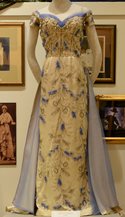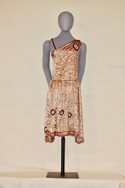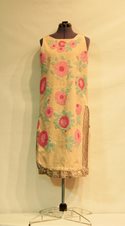Born in 1898 in Alabama, Ann Lowe learned the art of sewing from her mother and grandmother. During her 50-year career, she established herself as couture designer of stunning gowns, known for her hand-made, signature floral embellishments. Women whose names were on the social register, a governor’s wife, an Oscar Award winning actress and a future first lady were among Lowe’s elite clientele.
Today, some of Lowe’s dresses are housed at the Metropolitan Museum of Art's Costume Institute, the Smithsonian Institution's National Museum of African American History and Culture, and the Henry Plant Museum.
Why are three of Ann Lowe’s gowns at the Henry Plant Museum?
In 1915, Lowe traveled to Tampa to make dresses for Mrs. D.C. Lee. Soon, many in Tampa’s society sought a gown by Lowe. Lowe operated a dressmaking salon in Tampa until she moved to New York City in 1927. While in Tampa, she made a number of formal dresses for events related to the annual Gasparilla festivities. In 1924, Lowe was commissioned as dressmaker for the Gasparilla Court.
The Henry Plant Museum houses the Gasparilla Collection for the Henry B. Plant Museum Society. The three Lowe gowns in their collection were made for Gasparilla events.
The Henry B. Plant Museum Society funded the extensive conservation and detailed photography and scanning of the dresses. From the scans, 3D models of the dresses were assembled. Use your mouse or trackpad to zoom in, rotate, and see some of the detail on the models of the dresses below.
Gasparilla 3 Eva 20190220 MA Final Low Res 300k by plantmuseum on Sketchfab
Gasparilla Jewel Circle Gown worn by Rebecca Davies Smith (Mrs. Armin H. Smith, Jr.) in  1957
1957
Ms. Davies’ dress is made of cream-colored satin with a sweetheart bodice decorated with strands of beads and small pearls that form intricate twisting vine forms and flowers. The dress is designed to be worn just off the shoulders and features concealed spaghetti straps for support. Sheer layers of light blue tulle netting line the top of the bodice, sleeves and the short train. The bodice is lined with an inner boned corset. There is a half-circle shaped cream satin train attached to the gown at the back of the waist.
Gasparilla 2 300k by plantmuseum on Sketchfab
Gasparilla Court Gown worn by Katherine Broaddus (Mrs. Archibald Livingston, Jr.) in 1926
Maid Broaddus’ dress is made of metallic gauze over red silk fabric lining. The dress features an ornate starburst design decoration made of handsewn rhinestones, red sequin beads, and red jeweled stones. The shoulder area has a large jeweled medallion in the upper left of the dress and a series of smaller medallions towards the bottom of the skirt. The dress features one jeweled spaghetti strap.

Gasparilla Queen’s Gown worn by Sara Lykes Keller (Mrs. W. Frank Hobbs) in 1924
Queen Keller’s dress is a sleeveless hand-sewn dress made of yellow and gold silk faille fabric with intricate floral designs. It features large pink and green beaded flower embellishments and a two-inch wide band of rows with silver rocaille beads.
This dress is historically significant as the earliest confirmed example of Lowe's work.